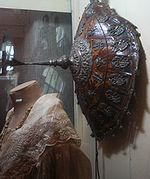
Salakot
Encyclopedia


Rattan
Rattan is the name for the roughly 600 species of palms in the tribe Calameae, native to tropical regions of Africa, Asia and Australasia.- Structure :...
or reeds
Phragmites
Phragmites, the Common reed, is a large perennial grass found in wetlands throughout temperate and tropical regions of the world. Phragmites australis is sometimes regarded as the sole species of the genus Phragmites, though some botanists divide Phragmites australis into three or four species...
. It is one of the traditional hats worn by Filipinos besides the conical Asian hat which is worn widely in East Asia and other Southeast Asian countries.
An ancient tradition recounts that the first Malay settlers in the archipelago purchased the valleys and plains of the Island of Panay in the Philippines from the native Aeta
Aeta
The Aeta , Agta or Ayta are an indigenous people who live in scattered, isolated mountainous parts of Luzon, Philippines. They are considered to be Negritos, who are dark to very dark brown-skinned and tend to have features such as a small stature, small frame, curly to kinky afro-like textured...
s in exchange for a golden salakot and a very long pearl necklace called a manangyad which touched the ground when worn by the wife of the Aeta
Aeta
The Aeta , Agta or Ayta are an indigenous people who live in scattered, isolated mountainous parts of Luzon, Philippines. They are considered to be Negritos, who are dark to very dark brown-skinned and tend to have features such as a small stature, small frame, curly to kinky afro-like textured...
chieftain.
The salakot is a common symbol for Filipino identity. It is often portrayed as the hat worn by Juan de la Cruz
Juan de la Cruz
Juan dela Cruz is the national personification used in the Philippines to represent the "Filipino". The name, Spanish for "John of the Cross", is roughly the equivalent of the American Uncle Sam and John Doe. Juan dela Cruz is usually depicted wearing the native Salakot hat, Barong Tagalog, long...
, the symbol of the collective Filipino psyche equivalent to Uncle Sam
Uncle Sam
Uncle Sam is a common national personification of the American government originally used during the War of 1812. He is depicted as a stern elderly man with white hair and a goatee beard...
of the Americans. The custom of embellishing this Filipino headgear developed as a practice during the Spanish Regime. Though normally worn by farmers, the wealthy and landed Christian Filipinos and mestizos (especially the members of the Principalía
Principalia
The Principalía or noble class was the ruling and, usually, the educated upper class in the towns of colonial Philippines, composed of the Gobernadorcillo , and the Cabezas de Barangay who governed the districts. The distinction or status of being part of the Principalía is a heriditary right...
), would also use the salakot, emboss this hat with silver, and sometimes hang silver coins and pendants around the headgear's brim. Many depictions of gobernadorcillo
Gobernadorcillo
The Gobernadorcillo was a municipal judge or governor in the Philippines during the Spanish colonial period, who carried out in a town the combined charge or responsibility of leadership, economic, and judicial administration. The Gobernadorcillo was the leader of a town or pueblo . In a coastal...
s and cabezas de barangay would portray these public functionaries during the colonial period wearing ornate salakots. It was not uncommon for this class to wear salakots made of more precious materials (like tortoise shell and precious metals).

